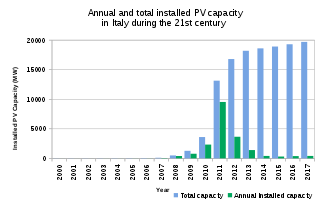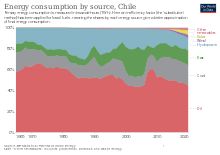
Energy in the United Kingdom came mostly from fossil fuels in 2021. Total energy consumption in the United Kingdom was 142.0 million tonnes of oil equivalent in 2019. In 2014, the UK had an energy consumption per capita of 2.78 tonnes of oil equivalent compared to a world average of 1.92 tonnes of oil equivalent. Demand for electricity in 2023 was 29.6 GW on average, supplied through 235 TWh of UK-based generation and 24 TWh of energy imports.
The energy policy of India is to increase the locally produced energy in India and reduce energy poverty, with more focus on developing alternative sources of energy, particularly nuclear, solar and wind energy. Net energy import dependency was 40.9% in 2021-22. The primary energy consumption in India grew by 13.3% in FY2022-23 and is the third biggest with 6% global share after China and USA. The total primary energy consumption from coal, crude oil, natural gas, nuclear energy, hydroelectricity and renewable power is 809.2 Mtoe in the calendar year 2018. In 2018, India's net imports are nearly 205.3 million tons of crude oil and its products, 26.3 Mtoe of LNG and 141.7 Mtoe coal totaling to 373.3 Mtoe of primary energy which is equal to 46.13% of total primary energy consumption. India is largely dependent on fossil fuel imports to meet its energy demands – by 2030, India's dependence on energy imports is expected to exceed 53% of the country's total energy consumption.

Brazil is the 7th largest energy consumer in the world and the largest in South America. At the same time, it is an important oil and gas producer in the region and the world's second largest ethanol fuel producer. The government agencies responsible for energy policy are the Ministry of Mines and Energy (MME), the National Council for Energy Policy (CNPE), the National Agency of Petroleum, Natural Gas and Biofuels (ANP) and the National Agency of Electricity (ANEEL). State-owned companies Petrobras and Eletrobras are the major players in Brazil's energy sector, as well as Latin America's.

In Honduras, there is an important potential of untapped indigenous renewable energy resources. Due to the variability of high oil prices and declining renewable infrastructure costs, such resources could be developed at competitive prices.
The electricity sector in Argentina constitutes the third largest power market in Latin America. It relies mostly on thermal generation and hydropower generation (36%). The prevailing natural gas-fired thermal generation is at risk due to the uncertainty about future gas supply.
As of August 2020 Chile had diverse sources of electric power: for the National Electric System, providing over 99% of the county's electric power, hydropower represented around 26.7% of its installed capacity, biomass 1.8%, wind power 8.8%, solar 12.1%, geothermal 0.2%, natural gas 18.9%, coal 20.3%, and petroleum-based capacity 11.3%. Prior to that time, faced with natural gas shortages, Chile began in 2007 to build its first liquefied natural gas terminal and re-gasification plant at Quintero near the capital city of Santiago to secure supply for its existing and upcoming gas-fired thermal plants. In addition, it had engaged in the construction of several new hydropower and coal-fired thermal plants. But by July 2020 91% of the new capacity under construction was of renewable power, 46.8% of the total solar and 25.6% wind, with most of the remainder hydro.

Renewable energy in Spain, comprising bioenergy, wind, solar, and hydro sources, accounted for 15.0% of the Total Energy Supply (TES) in 2019. Oil was the largest contributor at 42.4% of the TES, followed by gas, which made up 25.4%.

Energy in Mexico describes energy, fuel, and electricity production, consumption and import in Mexico.
Brazil has the largest electricity sector in Latin America. Its capacity at the end of 2021 was 181,532 MW. The installed capacity grew from 11,000 MW in 1970 with an average yearly growth of 5.8% per year. Brazil has the largest capacity for water storage in the world, being dependent on hydroelectricity generation capacity, which meets over 60% of its electricity demand. The national grid runs at 60 Hz and is powered 83% from renewable sources. This dependence on hydropower makes Brazil vulnerable to power supply shortages in drought years, as was demonstrated by the 2001–2002 energy crisis.

Energy in Finland describes energy and electricity production, consumption and import in Finland. Energy policy of Finland describes the politics of Finland related to energy. Electricity sector in Finland is the main article regarding electricity in Finland.

Energy in Austria describes energy and electricity production, consumption and import in Austria. Austria is very reliant on hydro as an energy source, supported by imported oil and natural gas supplies. It is planned by 2030 to become 100% electricity supplied by renewable sources, primarily hydro, wind and solar.

The electricity sector in Switzerland relies mainly on hydroelectricity, since the Alps cover almost two-thirds of the country's land mass, providing many large mountain lakes and artificial reservoirs suited for hydro power. In addition, the water masses drained from the Swiss Alps are intensively used by run-of-the-river hydroelectricity (ROR). With 9,052 kWh per person in 2008, the country's electricity consumption is relatively high and was 22% above the European Union's average.

The Polish energy sector is the fifth largest in Europe. By the end of 2023, the installed generation capacity had reached 55.216 GW, while electricity consumption for that year was 167.52 TWh and generation was 163.63 TWh, with 26% of this coming from renewables.

Primary energy consumption in Spain in 2020 was mainly composed of fossil sources. The largest sources are petroleum (42.3%), natural gas (19.8%) and coal (11.6%). The remaining 26.3% is accounted for by nuclear energy (12%) and different renewable energy sources (14.3%). Domestic production of primary energy includes nuclear (44.8%), solar, wind and geothermal (22.4%), biomass and waste (21.1%), hydropower (7.2%) and fossil (4.5%).

Solar power is an important contributor to electricity generation in Italy, accounting for 11.8% of total generation in 2023, up from 0.6% in 2010 and less than 0.1% in 2000.

Solar power in Mexico has the potential to produce vast amounts of energy. 70% of the country has an insolation of greater than 4.5 kWh/m2/day. Using 15% efficient photovoltaics, a square 25 km (16 mi) on each side in the state of Chihuahua or the Sonoran Desert could supply all of Mexico's electricity.
Renewable energy in Chile is classified as Conventional and Non Conventional Renewable Energy (NCRE), and includes biomass, hydro-power, geothermal, wind and solar among other energy sources. Usually, when referring to Renewable Energy in Chile, it will be the Non Conventional kind.
Uzbekistan had a total primary energy supply (TPES) of 48.28 Mtoe in 2012. Electricity consumption was 47.80 TWh. The majority of primary energy came from fossil fuels, with natural gas, coal and oil the main sources. Hydroelectricity, the only significant renewable source in the country, accounted for about 2% of the primary energy supply. Natural gas is the source for 73.8% of electricity production, followed by hydroelectricity with 21.4%.
Myanmar had a total primary energy supply (TPES) of 16.57 Mtoe in 2013. Electricity consumption was 8.71 TWh. 65% of the primary energy supply consists of biomass energy, used almost exclusively (97%) in the residential sector. Myanmar’s energy consumption per capita is one of the lowest in Southeast Asia due to the low electrification rate and a widespread poverty. An estimated 65% of the population is not connected to the national grid. Energy consumption is growing rapidly, however, with an average annual growth rate of 3.3% from 2000 to 2007.












